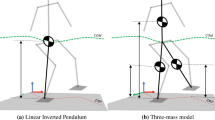Abstract
The proposed method can generate an optimal feedforward control input and the corresponding optimal walking trajectory minimizing the \(L_2\) norm of the control input by iteration of laboratory experiments. Since a general walking motion involves discontinuous velocity transitions caused by the collision with the ground, the proposed method consists of the combination of a trajectory learning part and an estimation part of the discontinuous state transition mapping using the stored experimental data. We apply the proposed method to a kneed biped robot with a torso, where we also provide a technique to generate an optimal gait not only being energy-efficient but also avoiding the foot-scuffing problem.






Similar content being viewed by others
References
Asano F (2016) A novel gait generation method independent of target settling-time adjustment for underactuated limit cycle walking. Multibody Syst Dyn 37(2):227–244
Asano F, Luo ZW (2008) Energy-efficient and high-speed dynamic biped locomotion based on principle of parametric excitation. IEEE Trans Robot 24(6):1289–1301
Benesty J, Paleologu C, Ciochină S (2011) Regularization of the RLS algorithm. IEICE Trans Fundam E94–A(8):1628–1629
Crouch PE, van der Schaft AJ (1987) Variational and Hamiltonian control systems. Lecture notes on control and information science, vol 101. Springer, Berlin
Fujimoto K, Horiuchi T, Sugie T (2008) Iterative learning optimal control of Hamiltonian systems based on variational symmetry. Trans Inst Syst Control Inf Eng 21(1):10–17 (in Japanese)
Fujimoto K, Koyama I (2008) Iterative feedback tuning for Hamiltonian systems. In: Proceedings of the 17th IFAC world congress, pp 15,678–15,683
Fujimoto K, Sugie T (2001) Canonical transformation and stabilization of generalized Hamiltonian systems. Syst Control Lett 42(3):217–227
Fujimoto K, Sugie T (2003) Iterative learning control of Hamiltonian systems: I/O based optimal control approach. IEEE Trans Autom Control 48(10):1756–1761
Goswami A, Espiau B, Keramane A (1997) Limit cycles in a passive compass gait biped and passivity-mimicking control laws. Autono Robots 4(3):273–286
Goswami A, Thuilot B, Espiau B (1996) Compass-like biped robot part I: stability and bifurcation of passive gaits. INRIA research report (2996)
Hyon S, Emura T (2005) Symmetric walking control: invariance and global stability. In: Proceedings of the IEEE ICRA, pp 1455–1462
Kato Y, Ikemata Y, Sano A, Hayashi Y, Fujimoto H (2010) A basic study for passive walking that added upper body by means of spring mechanism. In: Proceedings of the 13th international conference climbing and walking robots and the support technologies for mobile machines, pp 753–760
Kinugasa T, Ito T, Kitamura H, Ando K, Fujimoto S, Yoshida K, Iribe M (2015) 3D dynamic biped walker with flat feet and ankle springs: passive gait analysis and extension to active walking. J Robot Mechatron 27(4):444–452
Maschke B, van der Schaft AJ (1992) Port-controlled Hamiltonian systems: modelling origins and system theoretic properties. In: Proceedings of the 2nd IFAC symposium nonlinear control systems, pp 282–288
McGeer T (1990) Passive dynamic walking. Int J Robot Res 9(2):62–82
Osuka K, Kirihara K (2000) Motion analysis and experiments of passive walking robot QUARTET II. In: Proceedings of IEEE international conference on robotics and automation, pp 3052–3056
Sano A, Ikemata Y, Fujimoto H (2003) Analysis of dynamics of passive walking from storage energy and supply rate. In: Proceedings of IEEE international conference on robotics and automation, pp 2478–2483
Satoh S, Fujimoto K, Hyon S (2006) Gait generation for passive running via iterative learning control. In: Proceedings of IEEE/RSJ international conference on intelligent robots and systems, pp 5907–5912
Satoh S, Fujimoto K, Hyon S (2008) Biped gait generation via iterative learning control including discrete state transitions. In: Proceedings of the 17th IFAC world congress, pp 1729–1734
Satoh S, Fujimoto K, Hyon S (2013) Gait generation via unified learning optimal control of Hamiltonian systems. Robotica 31(5):717–732
Satoh S, Fujimoto K, Saeki M (2016) Transition to an optimal periodic gait by simultaneous input and parameter optimization method of Hamiltonian systems. Artif Life Robot 21(3):258–267
Satoh S, Ikeda M, Fujimoto K, Hayakawa Y (2010) Modification of learning optimal gait generation method in considering discontinuous velocity transitions. In: Proceedings of SICE 2010 annual conference, pp 2794–2799
Spong MW (1999) Passivity based control of the compass gait biped. In: Proceedings of IFAC world congress, pp 19–23
Ura D, Sugimoto Y, Sueoka Y, Osuka K (2017) Asymptotic realization of desired control performance by body adaptation of passive dynamic walker. J Robot Mechatron 29(3):480–489
Westervelt ER, Grizzle JW, Chevallereau C, Choi JH, Morris B (2007) Feedback control of dynamic bipedal robot locomotion. CRC Press, Boca Raton
Acknowledgements
This work was partially supported by JSPS KAKENHI Grant Numbers JP17H03282 and JP18K04202.
Author information
Authors and Affiliations
Corresponding author
Additional information
This work was presented in part at the 2nd International Symposium on Swarm Behavior and Bio-Inspired Robotics, Kyoto, October 29–November 1, 2017.
About this article
Cite this article
Satoh, S., Fujimoto, K. Gait generation for a biped robot with knees and torso via trajectory learning and state-transition estimation. Artif Life Robotics 23, 489–497 (2018). https://doi.org/10.1007/s10015-018-0476-4
Received:
Accepted:
Published:
Issue Date:
DOI: https://doi.org/10.1007/s10015-018-0476-4




